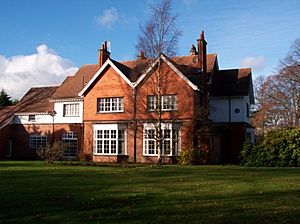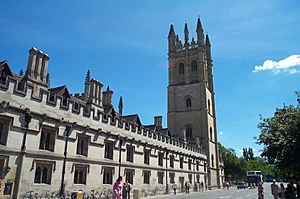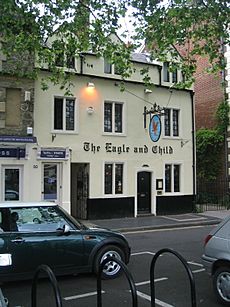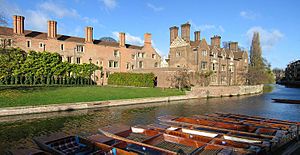C. S. Lewis facts for kids
Quick facts for kids
C. S. Lewis
|
|
|---|---|
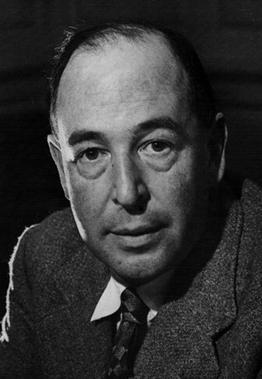
Lewis, age 48
|
|
| Born | Clive Staples Lewis 29 November 1898 Belfast, Ireland |
| Died | 22 November 1963 (aged 64) Oxford, England |
| Pen name | Clive Hamilton, N. W. Clerk |
| Occupation | Novelist, scholar, broadcaster |
| Alma mater | University College, Oxford |
| Genre | Christian apologetics, fantasy, science fiction, children's literature |
| Notable works | The Chronicles of Narnia Mere Christianity The Allegory of Love The Screwtape Letters The Space Trilogy Till We Have Faces Surprised by Joy: The Shape of My Early Life |
| Spouse | |
| Children | 2 step-sons; including Douglas Gresham |
| Relatives | Warren Lewis (brother) |
Clive Staples Lewis (29 November 1898 – 22 November 1963), usually called C. S. Lewis, was a British scholar who wrote about 40 books.
He was born in Belfast, Northern Ireland. He is famous for his fantasy works, essays, and writings on literature and theology.
Lewis' theological works are usually apologetics, the defence of Christianity.
His works have been translated into more than 30 languages. Lewis was a professor of literature at the University of Oxford and the University of Cambridge.
Lewis was married to American writer Joy Davidman (1915–1960) from 1956 until her death from bone cancer. He died of renal failure in Oxford.
His writing is popular with many people, and many of his books were made into movies. His most famous and popular fantasy work is The Chronicles of Narnia, which is a series of seven books.
He died in Oxford, Oxford-shire, England in 1963.
Contents
Biography
Childhood
Clive Staples Lewis was born in Belfast, Ireland, on 29 November 1898. His father was Albert James Lewis (1863–1929), a solicitor whose father Richard had come to Ireland from Wales during the mid-19th century. His mother was Florence Augusta Lewis, née Hamilton (1862–1908), known as Flora, the daughter of Thomas Hamilton, a Church of Ireland priest, and great granddaughter of both Bishop Hugh Hamilton and John Staples. He had an elder brother, Warren Hamilton Lewis (known as "Warnie"). He was baptised on 29 January 1899 by his maternal grandfather in St Mark's Church, Dundela.
When his dog Jacksie was killed by a car, the four-year old Lewis adopted the name Jacksie. At first, he would answer to no other name, but later accepted Jack, the name by which he was known to friends and family for the rest of his life. When he was seven, his family moved into "Little Lea", the family home of his childhood, in the Strandtown area of East Belfast.
As a boy, Lewis was fascinated with anthropomorphic animals; he fell in love with Beatrix Potter's stories and often wrote and illustrated his own animal stories. He and his brother Warnie created the world of Boxen, inhabited and run by animals. Lewis loved to read; his father's house was filled with books, and he felt that finding a book to read was as easy as walking into a field and "finding a new blade of grass".
Lewis was schooled by private tutors until age nine when his mother died in 1908 from cancer. He then went to varous schools during his teens.
In 1916, Lewis was awarded a scholarship at University College, Oxford. Lewis experienced a certain cultural shock on first arriving in England.
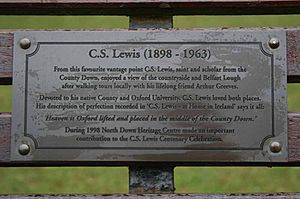
First World War and Oxford University
Lewis entered Oxford in the 1917 summer term, studying at University College, and shortly after, he joined the Officers' Training Corps at the university as his "most promising route into the army".
Within months of entering Oxford, the British Army shipped him to France to fight in the First World War.
On his 19th birthday (29 November 1917) he arrived at the front line in the Somme Valley in France, where he experienced trench warfare for the first time. On 15 April 1918, Lewis was wounded and two of his colleagues were killed by a British shell falling short of its target.
After Lewis returned to Oxford University, he received a First in Honour Moderations (Greek and Latin literature) in 1920, a First in Greats (Philosophy and Ancient History) in 1922, and a First in English in 1923.
In 1924 he became a philosophy tutor at University College and, in 1925, was elected a Fellow and Tutor in English Literature at Magdalen College, where he served for 29 years until 1954.
Janie Moore
During his army training, Lewis shared a room with another cadet, Edward Courtnay Francis "Paddy" Moore (1898–1918). Maureen Moore, Paddy's sister, said that the two made a mutual pact that if either died during the war, the survivor would take care of both of their families. Paddy was killed in action in 1918 and Lewis kept his promise. Paddy had earlier introduced Lewis to his mother, Janie King Moore, and a friendship quickly sprang up between Lewis, who was 18 when they met, and Janie, who was 45. The friendship with Moore was particularly important to Lewis while he was recovering from his wounds in hospital, as his father did not visit him.
In 1930, Lewis moved into The Kilns with his brother Warnie, Mrs. Moore, and her daughter Maureen. The Kilns was a house in the district of Headington Quarry on the outskirts of Oxford, now part of the suburb of Risinghurst. They all contributed financially to the purchase of the house, which passed to Maureen, who by then was Dame Maureen Dunbar, when Warren died in 1973.
Lewis lived with and cared for Moore until she was hospitalized in the late 1940s.
Moore suffered from dementia in her later years and was eventually moved into a nursing home, where she died in 1951. Lewis visited her every day in this home until her death.
Return to Christianity
Lewis was raised in a religious family that attended the Church of Ireland. He became an atheist at age 15, though he later described his young self as being "very angry with God for not existing" and "equally angry with him for creating a world".
He eventually returned to Christianity, having been influenced by arguments with his Oxford colleague and Christian friend J. R. R. Tolkien
Second World War
After the outbreak of the Second World War in 1939, the Lewises took child evacuees from London and other cities into The Kilns. Lewis was only 40 when the war started, and he tried to re-enter military service, offering to instruct cadets; but his offer was not accepted. He rejected the recruiting office's suggestion of writing columns for the Ministry of Information in the press, as he did not want to "write lies" to deceive the enemy. He later served in the local Home Guard in Oxford.
Honour declined
Lewis was named on the last list of honours by George VI in December 1951 as a Commander of the Order of the British Empire (CBE) but declined so as to avoid association with any political issues.
Joy Davidman
In later life, Lewis corresponded with Joy Davidman Gresham, an American writer. Lewis at first regarded her as an agreeable intellectual companion and personal friend, and it was on this level that he agreed to enter into a civil marriage contract with her so that she could continue to live in the UK. The civil marriage took place at the register office, 42 St Giles', Oxford, on 23 April 1956.
After complaining of a painful hip, she was diagnosed with terminal bone cancer, and the relationship developed to the point that they sought a Christian marriage. Since she was divorced, this was not straightforward in the Church of England at the time, but a friend, the Rev. Peter Bide, performed the ceremony at her bed in the Churchill Hospital on 21 March 1957.
Gresham's cancer soon went into remission, and the couple lived together until 1960, when her cancer recurred and she died on 13 July.
Lewis continued to raise Gresham's two sons after her death.
Illness and death
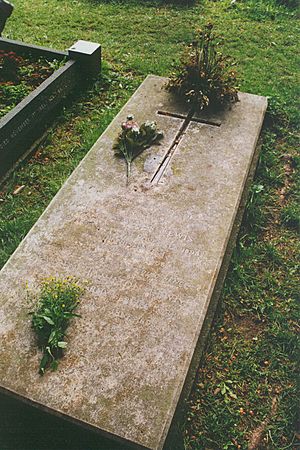
On 15 July 1963 he fell ill and was admitted to the hospital; he suffered a heart attack at 5:00 pm the next day and lapsed into a coma, unexpectedly waking the following day at 2:00 pm. After he was discharged from the hospital, Lewis returned to the Kilns, though he was too ill to return to work. As a result, he resigned from his post at Cambridge in August.
Lewis's condition continued to decline, and he was diagnosed with end-stage kidney failure in mid-November. He collapsed in his bedroom at 5:30 pm on 22 November, exactly one week before his 65th birthday, and died a few minutes later. He is buried in the churchyard of Holy Trinity Church, Headington, Oxford. His brother Warren died on 9 April 1973 and was buried in the same grave.
Media coverage of Lewis's death was almost completely overshadowed by news of the assassination of US President John F. Kennedy, which occurred on the same day (approximately 55 minutes following Lewis's collapse), as did the death of English writer Aldous Huxley, author of Brave New World.
Career
Scholar
Lewis began his academic career as an undergraduate student at Oxford University, where he won a triple first, the highest honours in three areas of study. He was then elected a Fellow of Magdalen College, Oxford, where he worked for nearly thirty years, from 1925 to 1954.
Lewis was a prolific writer, and his circle of literary friends became an informal discussion society known as the "Inklings", including J. R. R. Tolkien, Nevill Coghill, Lord David Cecil, Hugo Dyson, Charles Williams, Owen Barfield, and his brother Warren Lewis.
Novelist
In addition to his scholarly work, Lewis wrote several popular novels, including the science fiction Space Trilogy for adults and the Narnia fantasies for children. Most deal implicitly with Christian themes such as sin, humanity's fall from grace, and redemption.
His first novel after becoming a Christian was The Pilgrim's Regress (1933), which depicted his experience with Christianity in the style of John Bunyan's The Pilgrim's Progress.
He then wrote the Space Trilogy (also called the Cosmic Trilogy or Ransom Trilogy).
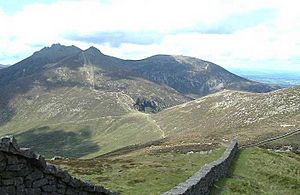
The Chronicles of Narnia is a series of seven fantasy novels for children and is considered a classic of children's literature. Written between 1949 and 1954 and illustrated by Pauline Baynes, the series is Lewis's most popular work, having sold over 100 million copies in 41 languages. It has been adapted several times, complete or in part, for radio, television, stage and cinema.
The books contain Christian ideas intended to be easily accessible to young readers. In addition to Christian themes, Lewis also borrows characters from Greek and Roman mythology, as well as traditional British and Irish fairy tales.
Legacy
In 2013, on the 50th anniversary of his death, Lewis joined some of Britain's greatest writers recognised at Poets' Corner, Westminster Abbey.
Lewis has been the subject of several biographies, a few of which were written by close friends, such as Roger Lancelyn Green and George Sayer. In 1985, the screenplay Shadowlands by William Nicholson dramatized Lewis's life and relationship with Joy Davidman Gresham. It was aired on British television starring Joss Ackland and Claire Bloom. This was also staged as a theatre play starring Nigel Hawthorne in 1989 and made into the 1993 feature film Shadowlands starring Anthony Hopkins and Debra Winger.
A bronze statue of Lewis's character Digory from The Magician's Nephew stands in Belfast's Holywood Arches in front of the Holywood Road Library.
Several C. S. Lewis Societies exist around the world, including one which was founded in Oxford in 1982.
Live-action film adaptations have been made of three of The Chronicles of Narnia: The Lion, the Witch, and the Wardrobe (2005), Prince Caspian (2008) and The Voyage of the Dawn Treader (2010).
Lewis is featured as a main character in The Chronicles of the Imaginarium Geographica series by James A. Owen. He is one of two characters in Mark St. Germain's 2009 play Freud's Last Session, which imagines a meeting between Lewis, aged 40, and Sigmund Freud, aged 83, at Freud's house in Hampstead, London, in 1939, as the Second World War is about to break out.
The CS Lewis Nature Reserve, on ground owned by Lewis, lies behind his house, The Kilns. There is public access.
Images for kids
See also
 In Spanish: C. S. Lewis para niños
In Spanish: C. S. Lewis para niños


